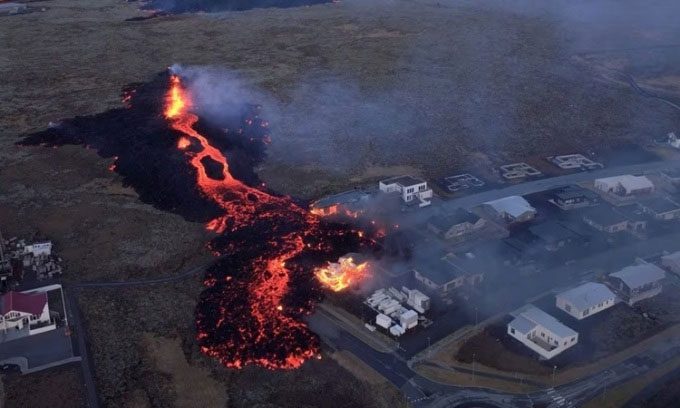With temperatures exceeding 1,000 degrees Celsius, very few materials can halt the flow of volcanic lava.
Lava flows erupted from the Sundhnúkur volcanic system in southwestern Iceland on January 14, 2024. The lava blocked several roads and surged from a new fissure into the suburbs of the coastal town of Grindavík, destroying at least three houses in its path. Nearby, construction vehicles that had been working for weeks to build earthen dams and barriers in an effort to redirect the lava were forced to retreat, according to Popular Science.
Humanity has attempted various methods to stop lava in the past, from trying to freeze it on-site with seawater to using explosives to block the supply and constructing barriers. It is still too early to determine whether the earthen dam in Iceland will successfully save Grindavík, which has around 3,500 residents and a nearby geothermal power plant. However, the most successful efforts to stop or redirect lava have included building barriers like those in Iceland.

Lava flowing from the volcano causing buildings in Grindavík to catch fire on January 14. (Photo: Bjorn Steinbekk).
Lava is a viscous liquid that flows slowly, resembling asphalt. It is influenced by gravity, so like other liquids, it will flow from higher to lower ground along the steepest paths. With molten rock temperatures often exceeding 1,000 degrees Celsius, very few materials can block the path of lava.
Freezing Lava on the Move
In 1973, the people of Iceland conducted the most famous experiment of “freezing lava.” They used water hoses from small boats and fishing vessels to protect the community on Heimaey Island from lava from the Eldfell volcano. The lava threatened to close a crucial harbor for the local fishing industry. The eruption ended before authorities could fully assess the success of this measure, but the harbor remained intact.
Dealing with Lava Using Explosives
Residents of Hawaii used explosives dropped from planes in 1935 and 1942 to block lava flows from Mauna Loa volcano threatening the town of Hilo on the Big Island. Their idea was to block channels or lava tubes in the volcano supplying lava to the surface. None of the attempts were successful. The explosives created many new channels, but the new lava flows quickly merged back into the previous channels.
Barriers and Redirecting Lava
Recent efforts have focused on the third method of building dams or channels to redirect the flow of lava along different slopes. The results have been mixed, but redirection will be successful if it can guide the lava into a separate area, allowing it to flow naturally without threatening other communities. However, many attempts to redirect lava have faced failures. For example, barriers built in Italy to block lava from Mount Etna in 1992 slowed the flow but ultimately, the lava overflowed them.
Iceland’s Lava Redirection Efforts
Icelandic authorities evacuated residents in Grindavík in November 2023 after a series of earthquakes indicated nearby volcanic systems were reactivating. Shortly after, construction of barriers to protect the town and critical infrastructure, including the Svartsengi geothermal power plant, began. Construction had to halt in mid-December when the first volcanic eruption occurred about 4 kilometers northeast of Grindavík, but resumed in January 2024. The construction continued as magma rose to the surface again on January 14.
Redirecting lava in this area is challenging, partly because the land around Grindavík is relatively flat. This makes identifying an alternative slope to divert the lava more difficult. On January 15, Icelandic authorities announced that most of the lava from the main fissure was flowing outside of the barriers; however, a new fissure opened within the outer perimeter, causing lava to flow into residential areas, thereby still threatening Grindavík.


















































